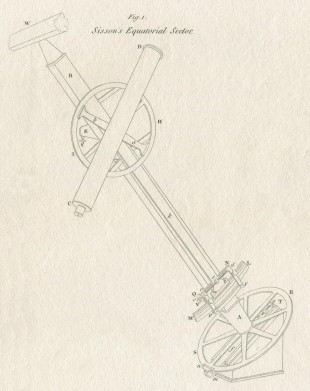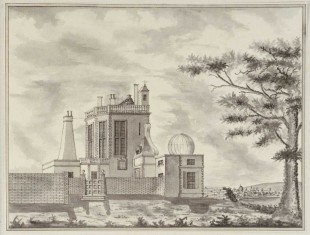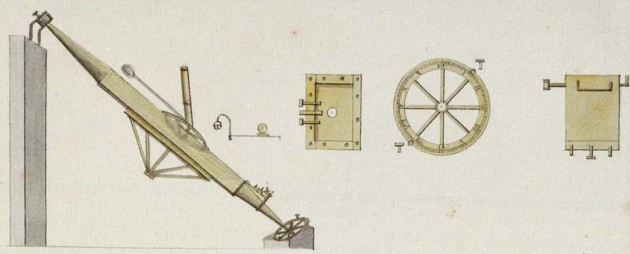…where east meets west
- Home
- Brief History
- The Greenwich Meridian
- Greenwich
(1675–1958) - Herstmonceux
(1948–1990) - Cambridge
(1990–1998) - Outstations (1822–1971)…
- – Chingford (1822–1924)
- – Deal
(1864–1927) - – Abinger
(1923–1957) - – Bristol & Bradford on Avon
(1939–1948) - – Bath
(1939–1949) - – Hartland
(1955–1967) - – Cape of Good Hope
(1959–1971)
- Administration…
- – Funding
- – Governance
- – Inventories
- – Pay
- – Regulations
- – Royal Warrants
- Contemporary Accounts
- People
- Publications
- Science
- Technology
- Telescopes
- Chronometers
- Clocks & Time
- Board of Longitude
- Libraries & Archives
- Visit
- Search
Telescope: Sisson's 5-foot Equatorial Sectors (I773)

Sisson's Equatorial Sector after modification in 1780 (engraved by C. Tiebout). Adapted from Plate XVII (Astronomical Instruments) of the American edition of Rees's Cyclopaedia, Plates Volume 1 (Philadelphia, c.1820)
Jeremiah Sisson made two 5-foot Equatorial Sectors for the Astronomer Royal, Nevil Maskelyne. Maskelyne intended to use them for measuring the position of comets by measuring their angular separation from stars whose positions were well known. He also proposed to use them to make measurements of the planetary positions (particularly Mercury), when their positions made them unable to be observed with the meridian instruments. Of poor design and construction, their story illustrates how the instrument makers on whom the Observatory depended, not only for the supply of new instruments, but more critically the regular servicing of existing equipment, were able to work to their own agendas and avoid being properly called to account.
A replacement for the earlier 2½-foot Equatorial Sector by George Graham, and a new location
Finding Graham’s Equatorial Sector wanting, Maskelyne asked for a replacement of 5-foot radius at the 12 July 1770 meeting of the Visitors. The Observatory site had not significantly expanded since Flamsteed’s time, and there being no suitable place with an unimpeded view of the whole sky, Maskelyne suggested two new observatory buildings each 12 feet square should be built to connect with the east and west sides of the Great Room (Octagon Room). It was proposed that the new instrument would be moved from one to the other as the need arose (RGO6/21/110). On the 24 October, the Visitors decided that it would be better to modify the two summerhouses than to provide new buildings. An inspection carried out by the Board of Ordnance found the foundations and walls of the summerhouses to be weak and of insufficient strength to accommodate the changes it thought were being asked for. But after clarification by Maskelyne, it was agreed that their conversion into domes would after all be possible without the need to take them down and rebuild them. As well as the fitting of a suitable dome, each had an extra story added and an extension built to the south to house a staircase. Click here to read more about Flamsteed House and the summerhouses.
Two instruments are necessary because of their poor location

The Observatory as it appeared between 1774 and 1779. The newly converted Eastern Summerhouse is on the right. From a drawing by John Charnock. Reproduced under the terms of the Creative Commons Attribution-Non-Commercial-ShareAlike (CC BY-NC-SA) licence courtesy of the National Maritime Museum, Greenwich, London (see below)
Of poor and inadequate construction
The sectors were soon found to be of inadequate construction, Maskelyne stating on 14 September 1775, that they had ‘some imperfections that rendered them incapable of all the necessary adjustments though the neglect of the instrument maker’ (RGO6/21/141). The Visitors together with the instrument makers Bird and Ramsden carried out an inspection. They found the sectors ‘so defective that it would be impossible to make use of them in their present state’. With Bird being too busy to take on extra work, the Visitors recommended that one of the instruments should be removed to Ramsden’s workshop for examination so that he could provide an estimate for such remedial work as was required. The western sector was duly removed and Ramsden’s findings considered by the board at a meeting of 26 October 1775.
A replacement is ordered from Ramsden
Ramsden reported that the polar axis was ‘very weak’ and would require considerable strengthening, and in his view, the meridian and equatorial circles were ‘much too small’ and that others should be substituted, as large as could be conveniently made. He also stated that ‘a long axis is absolutely necessary to be applied to the declination circle’. He estimated the cost of making the necessary alterations at not more than £150 – an amount equal of course to the original cost of the instrument (RGO6/21/143). In light of his findings, the visitors decided that rather than try to make the sectors serviceable, they should be disposed of and Ramsden asked to provide an estimate for an entirely new instrument. There was a lull in proceedings until 13 July 1778, when the visitors sanctioned Ramsden’s estimate of £500 for a new instrument incorporating the 5-foot telescope from the Sisson instrument. They asked the Board of Ordnance to pay Ramsden an advance of £200, which was duly done.
Ramsden fails to deliver, so Sisson’s Sectors are reluctantly upgraded
By 1779, the fixings required for the clocks had still not been put in place, presumably due to a lack of urgency as there were still no serviceable instruments in the domes. Then, on 4 July 1780, Maskelyne presented the visitors with a scheme to upgrade the eastern instrument. He recommended that a) the sector part be removed and a long index turning on the centre of the instrument to be adopted instead, b) that the telescope be made to turn on the centre of the instrument, and c), that two new indexes with verniers at right angles be fitted instead of the existing indexes.
These alterations were carried out by Sisson and had been completed by the time of the next visitation of 11 August 1781 (RGO6/21/194). Meanwhile, the western dome remained devoid of an observing instrument, the replacement from Ramsden being described as ‘in great forwardness’.

The Eastern Equatorial Sector after the 1780 alterations. Adapted from a drawing by John Charnock c.1785. Reproduced under the terms of the Creative Commons Attribution-Non-Commercial-ShareAlike (CC BY-NC-SA) licence courtesy of the National Maritime Museum, Greenwich, London (see below)
Sisson made what appears to be an identical sector for the Brera Observatory in Milan in 1774. Used by the famous astronomer Schiaparelli in the 1860s, it survives more or less intact in the Museo Nazionale della Scienza e della Tecnologia, and shows how the Greenwich Instrument might have looked prior to its modification. Click here for a photograph and description. Click here for a view from a different angle.
How much Sisson was paid to make the alterations is a matter of some conjecture. Howse (1975) states he was paid £89 9s, citing Royal Society MS371/5 as evidence. But this can only be surmise, as the itemised bill which this document refers to is missing and Sisson frequently did other work for the Observatory. His fee could just as likely have been included as part of his bill for £169 11s. (also missing) that was presented to the Visitors by Maskelyne for authorisation on 21 March 1782 (RGO6/21/197)
Ramsden is summoned to explain himself
On 16 January 1783, Ramsden was summoned to appear before the visitors to explain why he still hadn’t delivered the replacement instrument. Ramsden was full of excuses, but undertook to deliver it that July (RGO6/21/201). When the Visitors carried out their visitation on 25 of that month, they found it had still not been delivered. At their meeting six days later, they resolved that a committee should visit Ramsden on 14 August, ascertain the state of the instrument and make further visits to check on its progress as required. With the instrument still not ready in November 1784, Maskelyne suggested that as there was no immediate prospect of it materialising, the original Sisson sector should be put in order and returned to the western dome. The Ramsden instrument never did materialise. Was he required to pay back the £200? We do not currently appear to know. Greenwich however was not alone in its treatment by Ramsden. Something similar happened at the Dunsink Observatory in Ireland. The so-called Dunsink Circle was ordered from him in 1785. Although large sums of money were advanced over the following years, the Circle still not complete at the time of Ramsden’ death in 1800.
Dollond upgrades the optics
In August 1785, Maskelyne requested Dollond be employed to apply, a double eye glass with a positive focus to various of the instruments including the two equatorial sectors (at this point, the second sector had still to be returned). These had been supplied by the following August. Later that year, Maskelyne requested that Smeaton’s Equatorial Micrometer be adapted for the sector from the western dome in order to render it serviceable. Then, in November 1787, he requested that the western sector ‘be altered and made a serviceable instrument with the least expenditure possible that is to say that of £25, according to an estimate by Mr Troughton’ (RGO6/22/17). His request was approved by the visitors in January 1788. It appears that this was actioned, for in the published observations for the year 1811, observations are recorded from both domes during September and October, with a note that ‘about the end of September, a very excellent Wire Micrometer with two Moveable Threads, was added to the Sector in the Western Dome …’, implying that each dome did indeed contain a different sector!
Click here to view the observations of Enke’s comet made with the sector in September and October 1811.
Replacement of the eastern sector and conversion of the western
The observations of 1811 appear to be the last made with either of the sectors. The one in the eastern dome was removed in 1816 and placed in the ‘spare room’ (RS MS372/170). It was replaced with the Shuckburgh Equatorial which hade been made by Ramsden in 1791 and presented to the Observatory by Shukburgh’s heir in 1811. This instrument is said by Howse (1975) (and repeated by others), that it almost certainly contained parts originally made for the replacement sector that never materialised.
At some point (probably after 1818), The Royal Society committed one of the sectors to the care of John Herschel & James South for use in the construction of a 7-foot equatorial. This instrument was used for a series of observations of double and triple stars between 1821 & 1824 in South’s observatory in Blackman Street. It incorporated the polar axis together with the declination and hour circles from the Greenwich Instrument. (Phil Trans, 1824, p12).
There appear to be no references to observations being made in the west dome from 1811 (when the great comet of 1811 was observed from September though to December), until Enke’s Comet was observed from there in 1828. By then the remaining equatorial sector had been altered to a regular equatorial with, a shorter telescope. It was described by Airy in the 1843 volume of Greenwich Observations as well as those for 1844 and 1845:
This is a small telescope mounted on a long polar axis; the two pivots of the polar axis being at the two extremities of the polar axis, and the pivots of the short declination-axis being both on the same side of the telescope. The length of the polar axis is about 10 feet 3 inches; the diameter of the declination-circle and that of the hour-circle, 2 feet. The subdivision is effected by verniers. The length of the telescope is 2 feet 10 inches; the aperture of its object-glass, 3.5 inches. This is an instrument of an inferior class.
The inventory taken at the visitation of 1824 (RS MS371/70), together with a list of instruments compiled in 1818 (RS MS372/170), and an undated list from about 1823 (RS MS372/171), suggest this conversion took place in 1824 and that the new telescope incorporated the OG from Tulley’s 30-inch telescope in the Great Room. The great comet of 1823 was visible for a few months from the last few days of December. It was observed by John Pond, but only from the Eastern Dome. One might speculate it was the sighting of this comet that prompted Pond to make the instrument in the western dome more serviceable.
Click here to view the observations of Enke’s comet made with the new and modified instuments in 1828.
The modified western equatorial is sent to the Cape Observatory
The modified instrument remained in-situ in the western dome until 1845 when the polar axis, the declination-circle, and the hour-circle were sent to the Cape of Good Hope for the use of Mr. Maclear, the Astronomer Royal at the Cape. (Greenwich Observations 1845). In the autumn of 1847, the Cape’s 46-inch achromatic with an aperture of 3½ inches by Dollond was mounted on the polar axis and placed under a revolving dome. (Contributions to astronomy and geodesy, London, 1851, p.3). The dome at Greenwich was incorporated into the dwelling house by Airy in 1848. Today, the upper floors are used as offices by the staff of the Royal Museums Greenwich.
The Equatorial Sectors today
One of the sector parts removed in 1780 is conserved in the collections of the Royal Museums Greenwich. Click here to view. It is the only part known still to exist
Contemporary Accounts
Rees’s Cyclopædia in 39 Volumes.
Description: Volume 13, (London, 1819), Equatorial Sector by Mr. Jonathan Sisson
Plate: Plates Volume 1, (London, 1820), Astronomical Plate XVII, Fig. 1
The plate at the top of this page comes from the American edition of this account. A key together with a full description is contained in the description in Volume 13 to which a link is given above.
Vince, Samuel. A treatise on practical astronomy, (Cambridge, 1790), pp.141–8 & Plate V, Fig. 48
Image Credits and licensing arrangements
| Middle |
The Observatory as it appeared between 1774 and 1789. Cropped from a drawing by John Charnock. Reproduced under the terms of the Creative Commons Attribution-Non-Commercial-ShareAlike (CC BY-NC-SA) licence courtesy of the National Maritime Museum, Greenwich, London. Object ID: PAF2864. | |
| Bottom | The Eastern Equatorial Sector after the 1780 alterations. Adapted from a drawing by John Charnock c.1785. Reproduced under the terms of the Creative Commons Attribution-Non-Commercial-ShareAlike (CC BY-NC-SA) licence courtesy of the National Maritime Museum, Greenwich, London. Object ID: PAF2940. |
© 2014 – 2025 Graham Dolan
Except where indicated, all text and images are the copyright of Graham Dolan